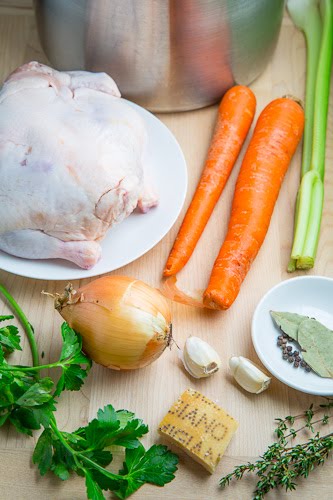How To Make Homemade Stocks
Whether you’re a cooking novice, or a seasoned chef, homemade stock is one of the greatest tricks you can arm yourself with. Homemade stock can elevate a simple dish to a whole new level. Many recipes call for it, but the store-bought boxed and canned kinds are bland and often taste like little more than salted water. Making stock from scratch is really easy, and completely worth the little bit of effort it takes.
There are several different ways to make stock, depending on what kinds of ingredients you’ll be using, and what type of stock you’re making. I’m not going to give you a concrete recipe here today, but are instead I’m going to introduce a couple of different techniques, and then at the end I’ll be sure to share a few of my favorite “recipes” with you – though the truth is, in all of the times I’ve ever made stock, I’ve never followed a recipe! It’s all about using what you have on hand, and making something delicious from that.
Vegetable Stock
Making a vegetable stock is different from making meat stocks, which I’ll get into later. When you make a meat stock – like chicken or beef – the stock flavor is extracted from the bones which get simmer for several hours, allowing the natural flavors to emerge. When you make a vegetable stock, its richness and flavor comes directly from the veggies you use – so the variety of veggies is key. Also important is to brown the veggies first. They become lightly caramelized, which will translate into a deeper, richer flavor with the final product. Also unlike meat stocks, vegetable stock only needs to be simmered for 1-1.5 hours, a long enough time to extract all of the flavor, but not so long that the vegetables start to break down and the flavor becomes muddied.
Much like meat stocks, a good vegetable stock begins with carrots, onions, celery and garlic – and a large stock pot. These are the core ingredients, but to achieve the best flavor, you’ll want to add as many other vegetables as you can. It’s largely a personal preference, so if you don’t like certain veggies, leave them out, but if you love others, throw them in! Here’s a list of flavoring ideas to get you started:
Fresh thyme or parsley
Bay leaf
Whole peppercorns
Parsnips
Fennel
Turnips
Rutabagas
Corn cobs
Leeks (especially the green parts)
Mushrooms (dried or fresh, including stems)
Tomatoes
Tomato paste
Fresh Ginger
Recipes to get you started:
Chicken Stock
There are a couple different ways to make chicken stock, which both yield delicious results. My favorite way to make it is to use leftover chicken carcasses, as this technique is super simple, and doesn’t require the purchase of any additional ingredients. Once you’re removed all of the meat off of a whole roasted chicken (or other chicken bones), you place all of bones in a stockpot with water and chopped up veggies, seasonings, whatever you like, and simmer over low heat for several hours, allowing all of the flavors to come out. Another great technique is to chop up chicken parts (backs, necks, wings and legs, etc.) and sauté them, to brown the skin and meat and bring out a deep caramelized flavor. Once they’re nice and golden brown, you add boiling water and other seasonings, and cook for about an hour, until the chicken is fully cooked through, and the broth is fragrant. This technique requires a shorter cooking time, but still products a rich, delicious stock.
Recipes to get you started:
Beef Stock
To make beef stock, the process is a bit different. To start, you’ll need plenty of meaty beef stock bones (like shank or neck bones). You want to get bones that have lots of marrow, as well as knuckle bones and veal bones if possible, for their gelatin. These bones get roasted in a hot oven until they’re nice and golden brown, and then added to a large stock pot with vegetables, seasonings, and plenty of water. Other recipes will suggest you saute the meat bones in a pot, which would yield similar results.
Once the bones are sufficiently roasted (or sauteed), the process is similar to making chicken stock – simmer to extract flavor from the bones and seasoning. You will want to periodically check the stock for fat, which will rise to the surface and should be skimmed off. (Note: don’t pour that fat down the drain, because it will solidify! Just save in a bowl and discard later.) Once the stock is done, you can strain and chill it. Any remaining fat will become solid on the top, making removal easy.
Recipes to get you started:
Food Network – Emeril Lagasse
Simply Recipes
We hope these recipes get you off to a good start – once you try homemade stocks, you’ll never go back!
Photo credit: Closet Cooking, Kitchen Konfidence, Beyond Wonderful



